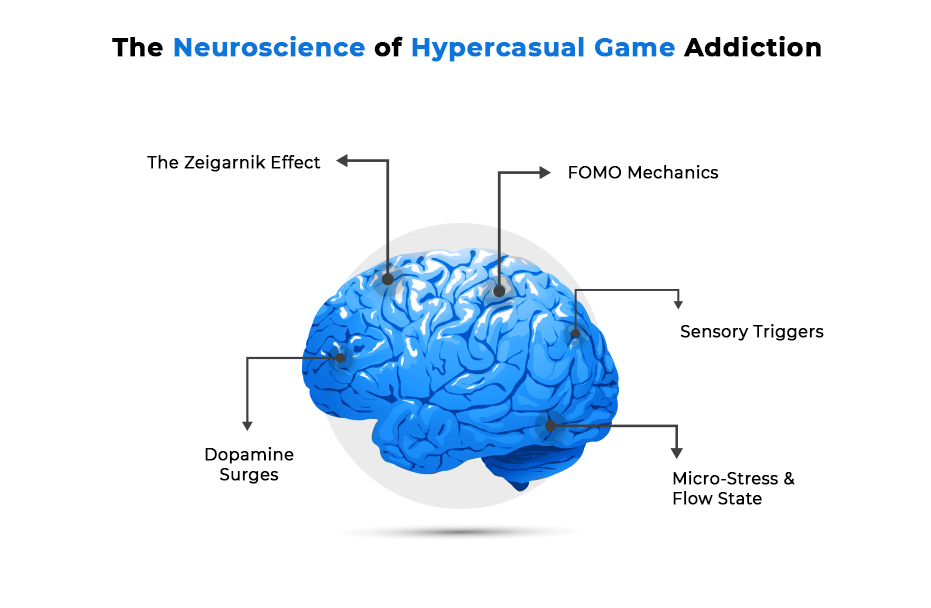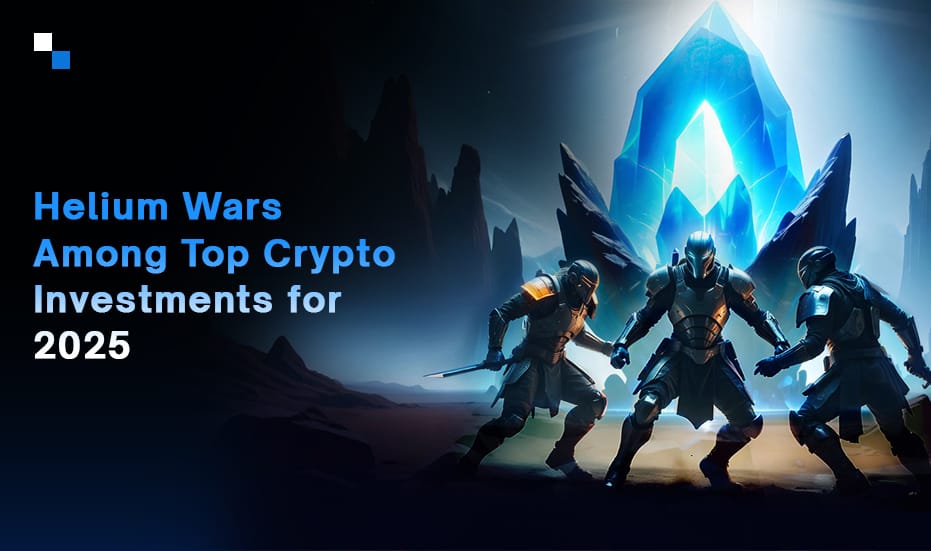
Build Real Estate Tokenization Platform: Technical Implementation and Considerations
February 19, 2025
Traditional vs. Blockchain-based Voting System- A Comparative Analysis
February 19, 2025The hypercasual gaming market is a $29.73 billion juggernaut projected to grow at an 8.2% CAGR through 2033.
What fuels this dominance?
It’s not just simplicity—it’s player psychology.
Hence, a hyper casual game development company, understands how to tap into subconscious human behaviors is what makes the difference between a fleeting hit and a viral sensation. This article dives into the five neuroscience-backed secrets that turn hypercasual games into addictive experiences, blending technical precision with psychological mastery.
Whether you’re a hypercasual game studio refining your portfolio or aiming to disrupt the market with a popular hyper casual game development, these insights will equip you to design games that players can’t put down. Let’s decode the science behind the swipe.

Addiction Neuroscience: What a Hyper Casual Game Development Company Can Focus on?
To truly understand why hypercasual games are so addictive, we must delve into the intricate workings of the human brain. At its core, addiction stems from a complex interplay of neurotransmitters, cognitive biases, and emotional triggers—all of which savvy developers can harness to create compelling experiences. Let’s break down the science behind it all.
1. Dopamine Surges: The Brain’s Reward System
Dopamine is kind of a central neurotransmitter that often plays a role in addictive experiences: that is, fun stuff. For giving a reward, levels achieved or points scored while playing the game will pump out dopamine in the human brain, resulting in an enjoyable feeling that could send one back to acting again. The really clever hyper casual game development company would design a multitude of these micro-rewards to keep dopamine levels consistently high. Most heavy casual games would have really big milestones, but hypercasual are based on micro-rewards that would spread over the entire gameplay.
However, too much stimulation leads to desensitization. Ensuring a careful balance between challenge and reward during hyper casual game development keeps the players coming back for more without, at the same time, burning out after two sessions. After all, no hypercasual game studio would want their users to burn out after just a few sessions.
2. The Zeigarnik Effect: Unfinished Business Keeps Players Hooked
Ever noticed how unfinished tasks tend to linger in your mind until you complete them? This phenomenon, known as the Zeigarnik Effect, plays a pivotal role in hyper casual game development and design. Players are naturally inclined to return to a game if they feel there’s still something left undone—be it reaching a new high score or unlocking the next stage.
A hyper casual game development company taps into this psychological principle effectively, by incorporating incomplete objectives or cliffhangers within the gameplay. For example, progress bars or countdown timers can remind players of their pending achievements. Leveraging such tactics can significantly boost daily active users (DAUs).
3. FOMO Mechanics: Leveraging Fear of Missing Out
Fear of Missing Out (FOMO) isn’t just limited to social media—it’s also a potent tool in game design. A hypercasual game studio frequently employs limited-time events, exclusive rewards, and seasonal updates to instill urgency among players. The idea is simple yet effective: make players believe they’ll miss out on something valuable unless they act now.
Consider games that offer bonus coins for logging in daily or special skins available only during holidays. These features trigger FOMO, compelling players to stay engaged regularly resulting in increased session lengths.
4. Sensory Triggers: Engaging the Senses for Maximum Impact
Humans are sensory creatures, and hypercasual games excel at stimulating multiple senses simultaneously. Bright colors, catchy sound effects, and tactile feedback combine to create an immersive experience that captivates players instantly. Visual cues like flashing lights when a goal is achieved or auditory signals accompanying successful actions reinforce positive behaviors. A well-designed hypercasual game development doesn’t just entertain—it engages the senses in ways that enhance enjoyment. No wonder a top-tier hyper casual game development company invests heavily in crafting polished audiovisual experiences.
5. Micro-Stress & Flow State: Balancing Challenge and Relaxation
Lastly, the most fascinating thing about hypercasual games is how they can put players into a state of flow—a mental state in which players are oblivious to time because they are totally engrossed in doing something. Flow is achieved through the discovery of the optimal level of harmony between skill and difficulty. Too easy, boredom ensues; too hard, and frustration ensues.
Enter micro-stress: brief spikes of tension that are rapidly resolved. Timing a jump just right, for instance, or narrowly avoiding an obstacle, creates just enough stress to keep players on their toes without being overwhelmed. By keeping this dynamic balance, a hyper casual game studio keeps the player in the desirable flow state for longer.

Secret #1: Simplistic Design with Deep Engagement
Simplicity is the foundation of hypercasual games, offering easy-to-pick-up yet engaging experiences. Beneath their minimalistic surface lies a carefully crafted mechanism for hyper casual game development to maximize engagement without overwhelming players.
1. Minimalism Meets Mastery
Hypercasual games distill mechanics into their purest form, stripping away clutter to create frictionless gameplay. This approach works because shorter attention spans demand simplicity. A hypercasual game studio thrives by avoiding convoluted controls or crowded interfaces that could deter players instantly.
2. How a Hypercasual Game Studio Can Master Simplicity
- Focus on One Core Mechanic: Every successful hyper casual game revolves around a single action—stacking, dodging, or matching.
- Iterate Based on Feedback: Early releases help gather player data, allowing developers to refine the experience.
- Polish Visuals and Audio: Vibrant visuals, smooth animations, and immersive sound effects enhance the minimalist gameplay, making it memorable for users.
For a hyper casual game development company, mastering these elements ensures both simplicity and engagement are balanced effectively.
Secret #2: Instant Gratification Through Quick Wins
Modern consumers crave instant gratification, and a hypercasual game studio leverages this by designing games that hook players immediately and keep them engaged.
1. The Science Behind Immediate Rewards
A hyper casual game development company structures gameplay around frequent, low-stakes victories to trigger dopamine release. For example, in Stack Ball , smashing blocks provides visual and auditory feedback, creating rewarding mini-celebrations.
2. Why Fast Feedback Loops Work
Feedback loops, like high scores or congratulatory messages, reinforce positive behaviors and encourage repetition. They also reduce cognitive load, making hypercasual games accessible to a broad audience, including non-traditional gamers.
3. Insights from Leading Hyper Casual Game Development Experts
Industry leaders highlight the importance of timing and pacing. The ideal session length for hypercasual games is 30 seconds to 5 minutes—long enough to engage but short enough to retain interest. A top hyper casual game development also incorporates variable rewards, surprising players with bonuses or challenges to maintain excitement and deepen engagement.
Secret #3: Hypercasual Game Studio Can Leverage Social Proof and Community Dynamics
Hypercasual games, known for their shareable nature, offer unique opportunities for growth. A hypercasual game studio can create a self-sustaining ecosystem by integrating features that encourage interaction, competition, and sharing. Leveraging social proof and community dynamics can turn a simple game into a cultural sensation.
1. Building Virality into Your Game
Virality is a measurable goal every hyper casual game development company strives for. Designing mechanics that incentivize sharing is key. Features like referral bonuses, multiplayer modes, and leaderboards naturally drive engagement. Leaderboards tap into players’ desire for recognition, while enabling score sharing on social media amplifies reach.
2. Encouraging Organic Growth Through Sharing
Sharing features are critical in hypercasual game design. They allow players to broadcast achievements, challenges, or funny moments, spreading awareness organically. Games like Among Us demonstrate the power of user-generated content. For a hyper casual game development, incorporating replay recording, customizable avatars, or humorous animations can boost visibility and organic growth significantly.
Secret #4: Data-Driven Iteration and Optimization
A hyper casual game development company must rely on data-driven iteration to stay competitive. Analyzing player behavior and conducting A/B tests are essential for success.
1. A/B Testing for Hypercasual Success
A hypercasual game studio can test variations like color schemes, button placements, or reward structures to optimize player engagement. For instance, testing a celebratory level-up screen versus a simple text notification helps identify what resonates best. Short development cycles allow quick implementation and measurable results.
2. Analyzing Player Behavior Patterns
Advanced analytics tools track touchpoints, drop-off points, and session durations. With this data, one can identify where players lose interest and take action for hyper casual game development. For example, if many users abandon the game during the tutorial, simplifying instructions or adding visual cues can help. If players struggle with a level, adjusting difficulty or offering hints may improve their experience.Behavioral insights also reveal motivations—daily rewards, leaderboards, or upgrades—guiding tailored updates.
Secret #5: Monetization Without Compromising Gameplay
Monetizing hypercasual games is a unique challenge for any hypercasual game studio, as they rely on ads and in-app purchases without alienating players. Striking the right balance between profitability and user experience is key to long-term success.
1. Ethical Ad Integration Strategies
Ads are the primary revenue source, but poor implementation can frustrate players. A hyper casual game development company should adopt ethical strategies like rewarded ads, where players earn benefits such as coins or power-ups for watching ads voluntarily. Non-intrusive banner ads at the screen’s edge and well-timed ads after levels or milestones also enhance user satisfaction while maximizing revenue.
2. Balancing Revenue Goals with User Experience
Overloading games with ads or pay-to-win mechanics can harm trust. Instead, hyper casual game development focuses on value creation through optional cosmetic upgrades, seasonal events, or limited-time offers. These tactics drive revenue while fostering player loyalty.
3. Lessons from Top-Grossing Studios
Games like Coin Master show that ethical monetization and engaging gameplay go hand in hand. By combining rewarded ads with fair in-app purchases, it proves players support games they love when monetization feels transparent. For an aspiring hypercasual game studio , balancing profitability with player satisfaction creates a win-win scenario for developers and users alike.
Start Hypercasual Game Development to Hook Players with Pro-Developers
The hypercasual gaming revolution has transformed digital entertainment by combining simplicity with strategic design. For a hyper casual game development company, understanding player psychology and leveraging neuroscience is key to creating addictive games. Success in this competitive space requires expertise and adaptability. Whether you’re part of a hypercasual game studio or starting your first project, the goal is to craft experiences that deeply resonate with players. To thrive, businesses must focus on continuous improvement and master the principles of hyper casual game development.
For those ready to enter the hypercasual gaming space, talk to experts at Antier. Their team can help you incorporate these strategies effectively, ensuring your game stands out and succeeds in a crowded market. Schedule a free consultation now to capitalize on the immense potential of hypercasual gaming.



